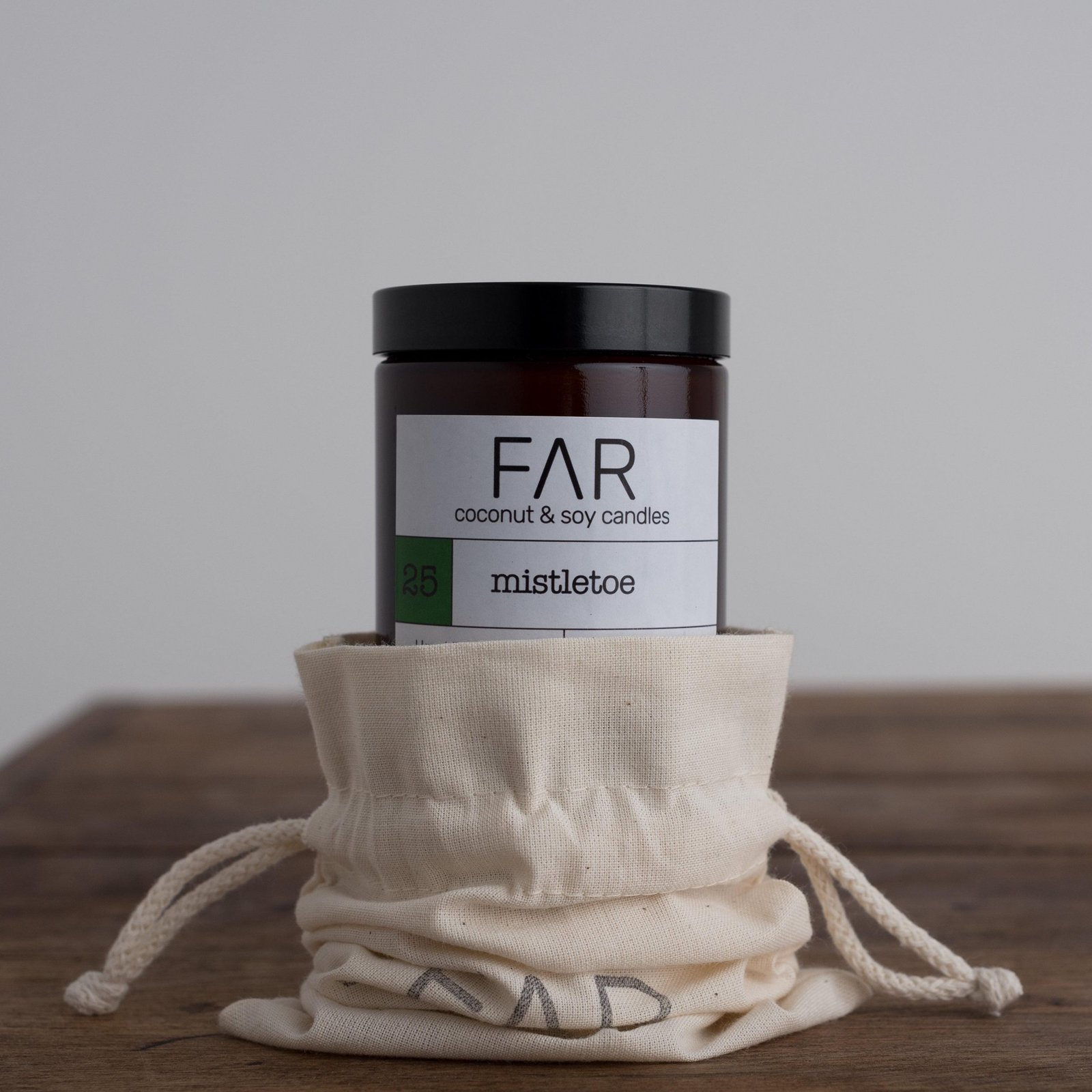
Discover the Best Brown Glass Jars for Candles: Enhance Your Home Decor with Style
You can find the best brown glass jars with quality scented candles at FAR Candles. a versatile choice for your home decoration

Amber glass candles can indeed be eco-friendly, but it largely depends on how they’re made. If created with recycled materials, their environmental impact is significantly lessened as this curbs the need for new glass production. Yet, it’s not just about sourcing. The end-of-life of these candles, or what happens to them when discarded, also factors into their eco-score. A perfect example here is soy wax candles; an ideal blend of sustainability and performance.
Contents
ToggleYes, our amber glass candles are considered eco-friendly. The use of glass reduces waste and can be easily recycled, while the soy wax in our candles is biodegradable, making them a sustainable choice for environmentally conscious customers.
Eco-friendliness is a crucial concern for many candle enthusiasts. When it comes to amber glass candles, their sustainability varies depending on the materials used, the production process, and the impact they have at the end of their lifespan.
Let’s begin by looking at the materials used. Amber glass candles are often made with soy wax, which has gained recognition as a sustainable and renewable resource. Unlike paraffin wax, which is derived from petroleum, soy wax is plant-based and biodegradable. This means that when you choose an amber glass candle made with soy wax, you’re supporting a more environmentally friendly option.
As a matter of fact, at Far Candles, we prioritise sustainability in our candle production. Our soy wax candles not only offer a cleaner and longer burn but also serve as a sustainable alternative to paraffin wax candles. The use of soy wax contributes to reduced reliance on non-renewable resources and supports an industry that promotes agricultural sustainability.
Moving on from materials, the production process plays a crucial role in determining the eco-friendliness of amber glass candles. Sustainable practices such as using recycled glass for the candle containers or sourcing materials locally can significantly reduce the environmental footprint of candle production. Furthermore, thoughtful packaging that minimises waste and utilises recyclable materials can enhance the overall sustainability profile of amber glass candles. At Far Candles, we are committed to reducing waste in every aspect of our operations, from packaging to shipping, to ensure that our products align with eco-friendly principles.
Finally, considering the end-of-life impact is essential when evaluating the eco-friendliness of any product, including candles. While amber glass jars are inherently recyclable and reusable, it’s important for consumers to properly dispose of them after the candle has been fully enjoyed. This encourages a circular economy where materials are continually repurposed, minimising waste and promoting sustainability.
For instance, after enjoying an amber glass candle from Far Candles, customers can repurpose the elegant jar for various uses such as storing small items or planting succulents. This adds value to the container beyond its initial purpose and aligns with sustainable practices.
In conclusion, while there are considerations regarding the eco-friendliness of amber glass candles, their sustainable aspects such as the use of soy wax and mindful production processes make them a viable choice for environmentally conscious consumers. When seeking eco-friendly candles, opting for soy wax-based alternatives like those offered by Far Candles can contribute to a greener lifestyle while enjoying the ambiance and fragrance of beautiful amber glass candles.
Assessing the use of recycled materials in amber glass candles sheds further light on their environmental impact and sustainable practices. Stay tuned as we uncover how these elements play a role in creating eco-friendly options for candle enthusiasts.
When assessing the environmental impact of candles, it’s not just about the wax and wick. The packaging also plays a vital role in the overall sustainability of the product. Amber glass candles packaged in recycled glass can make a significant difference in reducing the need for new glass production, crucial in lowering the environmental impact of the candle’s packaging. So, let’s break down how utilising recycled materials in candle packaging benefits sustainability.
Firstly, by using recycled amber glass for candle containers, we are actively contributing to sustainable practices. When candles are packaged in recycled glass, it reduces the demand for new glass production. This contributes to a circular economy and minimises the strain on natural resources that would otherwise be required for manufacturing new glass. Additionally, recycling glass helps decrease energy consumption which lessens carbon emissions – another step towards a greener planet.
Consider this example to better understand the impact. A comparison between candles using recycled amber glass and those using non-recycled amber glass reveals significant reductions in carbon emissions, energy consumption, and natural resource usage associated with using recycled materials. These comparisons illuminate the immense positive impact that recycled packaging can have on the environment.
Furthermore, it’s important to highlight that eco-friendly soy wax candles benefit widely from sustainable and recycled packaging materials—this extends beyond just using recycled amber glass. Incorporating sustainable practices into all aspects of candle production truly upholds our commitment to minimising environmental impact.
In doing so, we are able to see that by utilising recycled materials in amber glass candle packaging, we’re taking a significant step towards reducing waste, conserving resources, and fostering sustainable methods of production.
Now, let’s shift our focus to analyse the direct environmental impact of using recycled glass in amber candle production.
When considering the environmental impact of amber glass candles, multiple factors come into play. Beginning with the production process, each stage has its own effect on the environment. For example, energy consumption during manufacturing and transportation plays a significant role. At FarCandles, sustainable practices are prioritised in production and packaging to minimise the environmental footprint.
By sourcing soy wax for our candles, we contribute to reducing the demand for petroleum-based waxes, thereby decreasing reliance on fossil fuels. Furthermore, soy wax is biodegradable and has a lower environmental impact than paraffin wax, as it does not release toxic chemicals when burned. The emphasis on using natural ingredients aligns with our commitment to sustainability and sets our products apart as an eco-friendly choice.
In addition to the materials used, our manufacturing process is designed to minimise waste and energy consumption. We optimise our operations to reduce emissions and resource usage. Our commitment to eco-friendly practices extends to packaging, using recycled materials whenever possible, ensuring that our environmental impact is minimised at every stage of our product’s life cycle.
Another crucial aspect of sustainability is recyclability. Amber glass is 100% infinitely recyclable and choosing it over other materials helps reduce the use of non-renewable resources. Glass recycling also requires fewer raw materials and less energy compared to manufacturing new glass products from scratch. This means that choosing amber glass for candles aligns with our commitment to reducing waste and promoting a circular economy.
Lastly, transportation can have a notable impact on the environment. By partnering with carriers who prioritise sustainable practices, we aim to reduce the carbon footprint associated with the distribution of our products.
In summary, the environmental impact of amber glass candles encompasses various elements, from sourcing materials through to transportation and recyclability. It’s crucial for consumers to have access to products that align with their values and contribute positively to sustainable practices.
Moving forward, let’s delve into how consumers can further support environmental sustainability through conscious candle usage and disposal practices.
When it comes to candles, the materials used can significantly impact their carbon footprint. Amber glass candles are known for their durability, which is an important factor in assessing their overall environmental impact. The lifespan of these candles plays a significant role in their sustainability, as it affects how often they need to be replaced and therefore the amount of waste they generate.
Amber glass candles, with their sturdy construction and timeless design, are built to last. This means that they can be reused even after the candle has burned down completely. By repurposing the container with a new candle or for other purposes, you can significantly reduce waste and contribute to a more sustainable lifestyle. In contrast, single-use candles often end up in landfills once they have been fully used, which adds to environmental pollution.
Additionally, amber glass candles are recyclable, offering a more environmentally friendly option compared to traditional single-use candles. Recycling these containers reduces the need for new raw materials and lowers the overall energy consumption in the production process.
For comparison, soy wax candles also contribute to a lower carbon footprint. Soy wax is biodegradable and made from renewable resources, such as soybeans. This means that when burnt, soy wax candles produce less soot and toxins than paraffin wax candles. As a result, soy wax candles offer a clean-burning alternative that is both healthier for the environment and indoor air quality.
Furthermore, the biodegradability of soy wax allows it to naturally decompose without leaving harmful residue behind, making it a more sustainable choice for environmentally conscious consumers. The ability of soy wax candles to break down over time aligns with the principles of circular economy and sustainable resource management.
Considering these factors, it’s evident that both amber glass and soy wax candles offer greener alternatives with lower carbon footprints and sustainable properties. By choosing these eco-friendly options, consumers can make a positive impact on the environment while enjoying the ambiance and benefits of scented candles.
With a deeper understanding of the eco-friendly attributes of amber glass candles, let’s now explore their impact on sustainability and environmental conservation.
Amber glass candles contribute to a circular economy due to their repurposable nature. After enjoying the lovely candlelight and soothing scents, you can repurpose the amber glass jar. The glass can be thoroughly cleaned and given a new life as an elegant container for other items, such as storing small trinkets, bath salts, or even serving as a mini flower vase. This reuse reduces waste and adds charm and versatility to your home decor.
Furthermore, the recyclability of amber glass jars plays a significant role in promoting a more sustainable lifestyle. Once the candle has been enjoyed and the jar is no longer needed for repurposing, it can be recycled. This ensures that the glass does not end up in landfills but continues to be utilised in the production of new goods, perpetuating its useful life cycle.
In addition to the eco-friendly attributes of the packaging, it’s essential to highlight the core component—the candle itself. Soy wax candles epitomise sustainability with their clean-burning properties and biodegradable nature. Compared to conventional paraffin candles, soy wax candles offer a greener alternative by producing less soot and releasing fewer toxins into the air.
Moreover, sourcing soy from renewable crops adds to its sustainable profile. Farmers can continually cultivate and harvest soybeans, contributing to a more eco-conscious supply chain. This focus on renewable resources is crucial for reducing dependency on non-renewable materials, aligning with a more responsible approach toward product manufacturing.
The incorporation of biodegradable packaging further emphasises Far Candles’ commitment to sustainability. By opting for packaging materials that decompose naturally, we mitigate our impact on the environment and encourage eco-friendly practices within our industry.
Through these eco-friendly attributes, Amber Glass Candles serve as a standout example of sustainable packaging and an environmentally conscious product choice. Their capacity for reuse and recycling aligns with principles of circular economy, while our soy wax candles present a clean-burning, renewable alternative with biodegradable packaging—a testament to our dedication to environmental stewardship.
To unfold additional layers of sustainability considerations in candle choices, let’s compare the eco-friendliness and impact of Amber Glass Candles with other widely used candle bases.
When it comes to choosing candles, the type of wax they’re made from can significantly impact the environment. Paraffin is a common candle base derived from petroleum, making it a non-renewable resource. In contrast, amber glass candles are typically made from soy wax, a renewable resource that is biodegradable and non-toxic. This makes them a more environmentally friendly choice compared to paraffin candles.
Palm wax is another popular choice for candle-making, obtained from the oil palm tree. While palm wax is renewable, the cultivation of oil palm trees has been linked to deforestation and habitat destruction, particularly in regions like Southeast Asia. In comparison, soy wax used in amber glass candles is sourced from soybean oil, which is both renewable and domestically produced in many countries. Since soybean cultivation does not contribute to deforestation on a large scale, soy wax candles are considered more sustainable than palm wax candles.
Soy wax candles are not only better for the environment but are also healthier for you. When burned, they do not release harmful toxins or chemicals into the air, unlike paraffin candles which can emit carcinogens and other pollutants.
Soybeans are a sustainable and rapidly renewable resource, as they can be grown and harvested annually. This makes soy wax an environmentally responsible choice for candle production, especially when compared to paraffin or palm wax which rely on non-renewable resources or have significant environmental impacts associated with their sourcing.
The clean-burning nature of soy wax results in reduced indoor air pollution when compared to other types of candles. This is particularly important for individuals with respiratory conditions or sensitivities to airborne irritants.
In summary, amber glass candles made from soy wax offer a compelling combination of sustainability, non-toxicity, and minimal impact on indoor air quality, making them an excellent eco-friendly choice for conscientious consumers.
If you’re contemplating adding amber glass candles to your collection or replacing your current ones with a more eco-friendly option, there are a few vital aspects to consider. Making a choice that resonates with your values and supports sustainability is crucial, particularly for something as frequently used as candles.
Eco-Friendly Considerations: When seeking environmentally friendly candles, the material used is one of the most critical factors. Soy wax, for instance, stands out as a clean and sustainable choice that provides a superior alternative to traditional paraffin candles. Unlike paraffin, which is a petroleum by-product commonly found in lower-quality candles and releases harmful pollutants when burned, soy wax candles burn cleanly and produce minimal soot, making them a healthier option for both you and the environment.
Moreover, soy wax is derived from natural and renewable soybeans, creating a smaller carbon footprint compared to paraffin. This makes it an ideal choice for those looking to reduce their environmental impact without compromising on the quality of their candle experience.
Potential Drawbacks: While soy wax candles are an excellent eco-friendly alternative, it’s essential to address potential drawbacks. Not all soy candles are created equal; some may still contain additives such as paraffin to enhance scent throw and performance under certain conditions. It’s important to thoroughly research the brand and product you’re considering to ensure that it meets your eco-friendly standards. Look for transparent labelling and information about the candle’s ingredients and production processes.
Superior Alternative: As part of our commitment to sustainability and responsible consumption, our soy wax candles are made using high-quality, pure soy wax without any harmful additives. This ensures that our candles maintain their eco-friendly benefits while offering delightful scents and long-lasting burn times.
With careful consideration of these factors, consumers can make an informed decision that aligns with their environmentally conscious values while enjoying the superior qualities offered by soy wax candles.
In conclusion, if you’re looking to enhance your candle experience while prioritising sustainability, consider exploring our range of soy wax candles in amber glass jars at farcandles.com. Take a look at our scented candles with an amber jar.

You can find the best brown glass jars with quality scented candles at FAR Candles. a versatile choice for your home decoration

Knowing how to clean and maintain your amber glass candles doesn’t have to be tricky. Simple steps can significantly extend their lifespan
